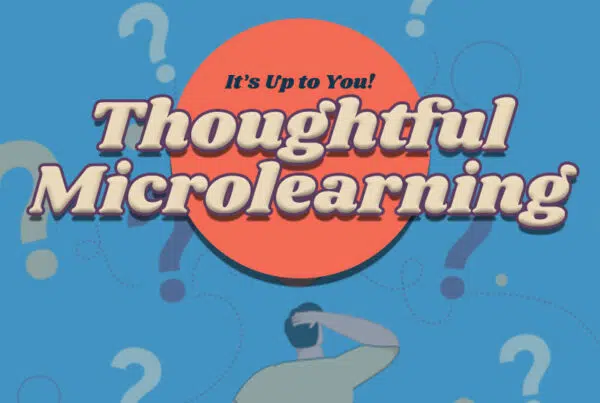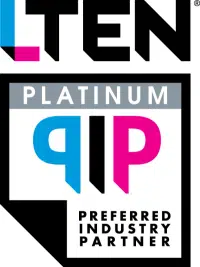Competition is more global and intense than ever, and even mature brands with stockpiles of resources understand that constant innovation is necessary to keep from falling behind. That innovation applies to products and services, obviously, but it also applies to how companies are run.
For example, successfully competing in industries where recruiting top talent is a challenge requires that elements within the organization be innovative too, elements like recruiting processes, onboarding, and corporate training. In fact, a strong learning culture is considered one of the strongest indicators of success in today’s business world.
And that means old school corporate training methods need to be seriously updated. While there can be a place for the lecture and notebook in today’s business learning environment, other, better options are available, and are proving to be reliable, effective, and fast. Competing effectively today means having a workforce that is continually learning and improving.
Learning researchers have established the strong connection between deeper insights and actual biological effects on the brain. When a person develops insights, the cortex – the largest part of the brain – lights up, so to speak. Since the cortex is in charge of “getting things done,” (executive functions), an activated cortex is a cortex that’s using knowledge. When learners reflect and reframe a new concept to create a personal connection with it, that’s when learning “sticks,” and this is precisely what today’s successful business training must pursue.
The Two Necessary Ingredients
Neurolearning is a learning methodology that makes learning – particularly eLearning – more effective. The key to retention of new insights is engagement with the learning experience, and the key to engagement is providing learners with outstanding quality learning content. This cognitive engagement, is visually stimulating and enjoyable, tapping into how the human brain takes in, stores, and assimilates information “by heart,” and it is made up of two basic cognitive ingredients.
One of the main components needed is visual storytelling. Great visual storytelling is what makes one YouTube video stay with you and cause you to think, while another evaporates almost instantly. Visual storytelling must grab the participant on a visual, metaphorical, and emotional level. It connects new information with a learner’s existing emotions, causing them to create a visual narrative in their brains, and human brains are quite adept at processing these narratives.
The other component of neurolearning is having the participant make use of information soon after it is delivered. Challenging the learner promptly, in a manner that’s fun and relevant, helps the learner lock down information. Challenges may be quizzes, role-play activities, simulations, or games, and they could hardly be more different from rote memorization. Memorization is redundant and doesn’t do much (if anything) to help learners reframe new information in ways that are meaningful. But smart challenges do exactly that.
Together, visual storytelling and smart challenges for the learner create something greater than the sum of their parts. Not only is new information stored, the learner has put it into some sort of context and made use of it, which is essential to long-term retention of new skills.
 Benefits of Neurolearning
Benefits of Neurolearning
Corporate learning that isn’t compelling wastes resources and doesn’t produce a strong return on the training investment. But engaging, interactive learning that presents material in a compelling manner and challenges the learner to use that information right away helps learners meet objectives, collaborate better, and develop a deeper understanding of company goals. Ultimate results can include increased sales, better customer support, and employees who are motivated and understand why they’re doing what they do. In other words, neurolearning benefits the individuals participating in it, their departments, and the organization overall.
Optimizing Visual Learning in eLearning
Visual learning is proving to be an amazingly effective elearning tool, and one indication of just how powerful visual learning can be comes from somewhere you might not expect: social media. Over the past couple of years, Instagram has become a social media juggernaut, particularly among younger users, whose brains are still in the process of developing functional capacity, impulse control, and planning behavior (executive functions, in other words).
The human appetite for information is virtually unquenchable, and our digital world is more than eager to provide information at a dizzying pace. Instagram’s major fan base (primarily young adults) feel the need to check their feed frequently to feed that appetite for information, and Instagram offers visual information that lights up the reward centers of the brain. Visual information is processed faster than written or audible information, and there is truth to the saying about a picture being worth 1,000 words.
It only makes sense to apply what we’re learning from the huge success of Instagram to elearning. That doesn’t mean that longer-form training is passé and serves no purpose. But it does give trainers tremendous insights into ways to make short-form information like updates and reminders as quickly effective as possible. In fact, the condensation of information into “bite sized” learning has been one of the more important developments in corporate learning of the past several years.
How Might This Apply to Pharma Sales Training?
“Always-on” learning isn’t quite the new normal in corporate training, but it’s something many organizations are thinking about. The idea is to break training out of a solely self-contained, intensive classroom environment and provide employees with access to training modules anytime, anywhere.
Teaching results of, say, new clinical trial results to pharma reps may not warrant significant time spent in a classroom, but the information is nonetheless valuable. Often the information can be packaged into digestible learning modules that reps can complete between client meetings, or before delivering samples to a physician practice.
New learning insights matter also because pharma sales training cannot afford to fall behind in terms of engaging learners and helping them excel. Recruiting and hiring outstanding pharma reps isn’t easy, and engaging them and giving them the training and tools they need to succeed in the field is mandatory for retaining outstanding people.
It’s widely accepted that ongoing education positively affects job performance, and the most successful businesses are the ones that understand training as less of a one-time event and more of a continuous part of the job. eLearning opens up possibilities that didn’t exist a few years ago, and research into topics like neurolearning helps trainers maximize effectiveness and ROI. If you’re interested in learning more, we invite you to check out our resources for sales trainers.

 Benefits of Neurolearning
Benefits of Neurolearning


